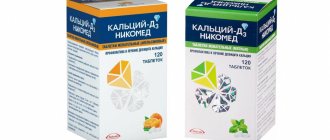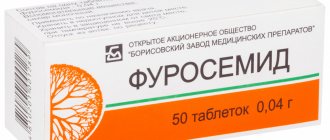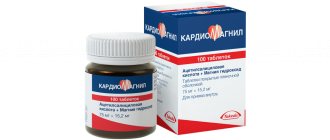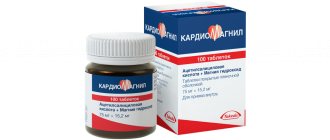Description of the drug
Calcium citrate with vitamin D3 is a dietary supplement from the American pharmaceutical company Solgar, a well-known manufacturer of highly effective drugs of natural origin. Available in the form of white tablets weighing 1540 mg. You can buy the drug in a dark glass jar, the package contains 60 pieces.
The main active ingredients are:
- calcium in the form of citrate in the amount of 250 mg;
- vitamin D3 in the amount of 150 IU.
Additionally, each tablet contains magnesium salt of stearic acid, glycerin, titanium and silicon dioxides, microcrystalline cellulose, vegetable cellulose and croscarmellose.
What are the benefits of Calcium Citrate with Vitamin D3 Solgar
The tablets are taken to ensure sufficient intake of calcium and vitamin D3 into the body. This substance is important for the prevention of osteoporosis, a pathology accompanied by bone fragility and loss of strength. Calcium is also necessary to maintain normal blood clotting, dental health, and normal functioning of the heart and nervous system.
Cholecalciferol is important for better absorption of calcium and phosphorus by the body. In Solgar Calcium Citrate with Vitamin D3, calcium is in an organic chelated form, facilitating easy absorption of the drug.
Combined preparations of calcium and vitamin D3: who to recommend and how to argue?
It is obvious that products containing colecalciferol can be considered the drugs of choice for the treatment and prevention of vitamin D insufficiency and deficiency: they are included in domestic and foreign clinical recommendations. But in what cases is it appropriate to recommend combined preparations of vitamin D and calcium to visitors and what should their attention be paid to?
From effect to indications
As you know, the main function of vitamin D is to regulate calcium-phosphorus metabolism. In the form of active metabolites, it takes part in the process of calcium absorption in the intestine and its excretion by the kidneys. In the presence of sufficient vitamin D, calcium absorption in the intestine is optimal. If the need for the “sunshine vitamin” is not compensated, calcium absorption decreases. Due to the low level of ionized calcium in the blood, the synthesis of parathyroid hormone is stimulated, which works to increase serum calcium, in particular, it stimulates the leaching of calcium and phosphorus from the bones. This chain of changes leads to a natural result of vitamin D deficiency - a decrease in calcium levels, changes in bone mineralization and, as a consequence, the development of rickets and osteoporosis.
Of course, there is no need to educate clients about these difficulties. Suffice it to say that hypovitaminosis D is associated with a negative calcium balance and decreased bone mineralization. These complications can be prevented by complex preparations of vitamin D and calcium, which potentiate the effect of each component. Their main task and leading indication is the prevention and treatment (as part of complex therapy) of osteoporosis, which usually develops in old age.
- It is appropriate to give preference to colecalciferol and calcium preparations when asking for drugs for the prevention and treatment of osteoporosis in women during or after menopause, as well as for strengthening bones in old age.
Dosage and course of treatment
According to the recommendations of the Russian Association of Endocrinologists, the preventive dose of vitamin D for 18-50 years old is 600-800 IU per day, and for those over 50 years old - 800-1000 IU per day. The dosage of calcium aimed at preventing bone density can be up to 2000 mg per day. In addition, existing recommendations indicate that for better absorption, a single dose of calcium should not exceed 600 mg.
Medicines - sources of vitamin D and calcium have balanced formulas and contain 200 or 400 IU of colecalciferol and 500 mg of calcium. All of them are taken 1 tablet 1-2 times a day, and the average dosage of the components supplied with them does not exceed the recommended daily doses.
- When dispensing drugs of this group to clients, it is appropriate to note that the dosage of the drugs is selected in such a way as to compensate for the body’s needs and to prevent excess vitamin and calcium. Therefore, you cannot independently increase the dose indicated in the instructions - this can lead to an increase in the level of calcium in the blood, which can impair the functioning of the kidneys and blood vessels.
Along with the dosage, it is important to follow the course of treatment recommended in the instructions. On average, it ranges from 4 to 6 weeks, but it may vary slightly for different drugs.
- When consulting a client, it should be emphasized that colecalciferol and vitamin D 3 for a long time without consulting a doctor .
Use during pregnancy, lactation, and childhood
Almost all drugs containing colecalciferol and vitamin D3 can be used during pregnancy and breastfeeding. However, we must not forget that hypercalcemia during pregnancy can adversely affect the development of the fetus. Therefore, the drugs themselves, and their dosage and course of treatment, should be selected by the attending physician.
Children's age is also not a contraindication to the use of the combination of colecalciferol + calcium. But, again, the doctor must decide on prescribing these drugs to children and select the dose and duration of therapy.
What else should you warn the client about?
When dispensing combined preparations of vitamin D and calcium, it is important to take into account that calcium salts reduce the pH of gastric juice, slow down gastric motility and, moreover, easily form complexes with a number of substances, which can interfere with the absorption of drugs. Therefore, it is better to take medications containing calcium separately from other medications - on average 2 hours before or 4-6 hours after, unless otherwise indicated.
In addition, you should remember the most common drug interactions with drugs from the following pharmacological groups:
- Antibiotics of the tetracycline group - when taken simultaneously with calcium supplements, the absorption of antibiotics may decrease. Therefore, tetracycline antibiotics should be taken at least 2 hours before or 4–6 hours after taking calcium supplements.
- Bisphosphonates – when taken simultaneously with colecalciferol and calcium, the absorption of bisphosphonates is reduced. Therefore, the time interval between the use of bisphosphonates and calcium supplements should be at least half an hour, and it is better to take them at different times of the day.
NB! Bisphosphonates are first-line drugs for the treatment of osteoporosis and can be part of a comprehensive treatment regimen along with vitamin D and calcium supplements.
- Cardiac glycosides and calcium channel blockers - when taken together with calcium supplements and/or vitamin D, it is recommended to monitor the level of calcium in the blood to avoid the development of hypercalcemia. The latter increases the risk of fatal arrhythmias in patients receiving digoxin and reduces the effectiveness of calcium channel blockers.
- Thiazide diuretics - reduce calcium excretion, which is associated with an increased risk of hypercalcemia. It is important for patients receiving these drugs to monitor serum calcium levels regularly.
We have listed only the most common drug interactions; their full list is much more extensive. And in order to prevent them, it is important to persistently recommend that the client take any medications separately from calcium and vitamin D preparations. And to make it easier for you to navigate the fairly large assortment, we have prepared a table for downloading, in which we have collected currently registered medications containing colecalciferol and calcium with dosages of active ingredients and indications. We hope that this information will help you easily and quickly select a drug for appropriate requests.
We answer questions live on VKontakte: https://vk.com/pharmznanie
You can discuss the latest news with all your Russian colleagues in chats:
Telegram: https://tglink.ru/pharmorden
VKontakte: https://vk.me/join/AJQ1d_D2XxaDy9IdzL0e6EqH
To leave a comment on this article, you need to register or log in.
Interested in the article? You can find out even more in the section Working in a pharmacy
Indications for use
The dietary supplement is indicated for preventive purposes and in the complex treatment of osteoporosis that develops during menopause, long-term use of glucocorticoids, or bone destruction due to an unknown reason.
Also, Calcium Citrate with Vitamin D3 is indicated for the prevention and treatment of bone fractures that occur as a complication of osteoporosis. Taking dietary supplements can compensate for calcium and cholecalciferol deficiency caused by poor nutrition.
A deficiency of substances can be suspected when:
- cramps in the limbs at night;
- weakness and constant fatigue;
- tingling in the legs and arms;
- dental problems;
- dry skin;
- sleep disorders;
- brittle hair and nails;
- high blood pressure.
The need for calcium and vitamin D3 increases in women during pregnancy and lactation, and in adolescents from 13 years of age entering a period of active growth and puberty.
Calcium D3-Nycomed tab zhev No. 60 strawberry-watermelon
Compound
Active ingredients: Excipients: sorbitol - 390 mg, strawberry-watermelon granulate flavor***** - 10.2 mg, povidone - 36.4 mg, magnesium stearate - 6 mg, aspartame - 1 mg.
* the amount of colecalciferol (vit. D3), including 10% excess, is 5.5 mcg, in the form of colecalciferol concentrate. ** colecalciferol concentrate contains, including 10% excess: colecalciferol - 0.0055 mg, alpha-tocopherol - 0.022 mg, modified corn starch - 1.607 mg, sucrose - 0.385 mg, sodium ascorbate - 0.088 mg, medium chain triglycerides - 0.066 mg, silicon dioxide - 0.026 mg.
***** strawberry-watermelon flavor granules contains: isomalt - 8.25 mg, strawberry-watermelon flavor - 0.276 mg, triacetin - 0.163 mg, esters of glycerol and diacetyltartaric and fatty acids - 0.0918 mg, medium-chain triglycerides - 0.0918 mg, water - 1.33 mg.
Pharmacokinetics
- Calcium
Absorption: Typically, the amount of calcium absorbed from the gastrointestinal tract is approximately 30% of the dose taken.
Distribution and Metabolism: 99% of calcium in the body is concentrated in the rigid structure of bones and teeth. The remaining 1% is found in intra- and extracellular fluids. About 50% of the total calcium content in the blood is in physiologically active ionized form, of which approximately 10% is complexed with citrate, phosphate or other anions, the remaining 40% is associated with proteins, primarily albumin.
Excretion: Calcium is excreted by the intestines, kidneys and sweat glands. Renal excretion depends on glomerular filtration and tubular reabsorption of calcium.
- Vitamin D3
Absorption: Vitamin D3 is easily absorbed in the small intestine (about 80% of the dose taken).
Distribution and metabolism: colecalciferol and its metabolites circulate in the blood bound to a specific globulin. Colecalciferol is converted in the liver by hydroxylation to 25-hydroxycolecalciferol. It is then converted in the kidneys to the active form 1,25-hydroxycolecalciferol. 1,25-hydroxycolecalciferol is a metabolite responsible for increasing calcium absorption. Unmetabolized vitamin D3 is stored in adipose and muscle tissue.
Excretion: Vitamin D3 is excreted by the intestines and kidneys.
Indications for use
- Prevention and treatment of calcium and/or vitamin D3 deficiency.
- Addition to specific therapy and prevention of osteoporosis and its complications (bone fractures).
Contraindications
- Hypercalcemia (increased concentration of calcium in the blood).
- Hypercalciuria (increased calcium in the urine).
- Nephrolithiasis.
- Hypervitaminosis D.
- Hypersensitivity to the components of the drug.
- Hypersensitivity to soy or peanuts.
- Severe renal failure.
- Active tuberculosis.
The drug in tablet dosage form is not used in children under 3 years of age.
Calcium-D3 Nycomed contains aspartame, which is transformed into phenylalanine in the body. Therefore, the drug should not be taken by patients with phenylketonuria.
Chewable tablets (orange, mint) contain sorbitol, isomalt and sucrose. Chewable tablets (strawberry-watermelon) contain sorbitol and sucrose. Use is not recommended for patients with hereditary fructose intolerance, glucose-galactose malabsorption or sucrase-isomaltase deficiency.
Carefully:
Pregnancy, lactation, renal failure.
Calcium carbonate with colecalciferol should be administered with caution to patients with sarcoidosis, due to the risk of increasing the metabolism of vitamin D3 to its active form. In these patients, it is necessary to monitor the concentration of calcium in the blood serum and urine.
Directions for use and doses
Calcium-D3 Nycomed is taken orally.
The tablets can be chewed or dissolved and taken with meals.
Prevention and treatment of calcium and/or vitamin D3 deficiency Adults and children over 12 years of age - 1 tablet 2 times a day, or 2 tablets once a day.
Children from 5 years to 12 years - 1-2 tablets per day.
Children from 3 to 5 years old - dosage in accordance with the doctor’s recommendations.
Addition to specific therapy and prevention of osteoporosis and its complications (bone fractures)
Adults - 1 tablet 2-3 times a day.
Special patient groups
Patients with impaired liver function:
No dose adjustment is required.
Patients with impaired renal function:
The drug Calcium-D3 Nycomed should not be used in case of severe renal failure.
Elderly patients:
The dose is the same as for adults. A possible decrease in creatinine clearance should be taken into account.
Duration of treatment
When used for the prevention and treatment of calcium and/or vitamin D3 deficiency, the average duration of treatment is at least 4-6 weeks. The number of repeat courses during the year is determined individually.
When used to complement specific therapy and prevention of osteoporosis and its complications (bone fractures), the duration of treatment is determined by the doctor individually.
Storage conditions
Keep the bottle tightly closed at a temperature not exceeding 25°C.
Keep out of the reach of children.
Best before date
2.5 years. Do not use after expiration date.
special instructions
- During long-term therapy, serum calcium and creatinine levels should be monitored. Monitoring is especially important in elderly patients during concomitant treatment with cardiac glycosides and diuretics (see section “Interactions with other drugs and foods”) and in patients with an increased tendency to form kidney stones. In cases of hypercalcemia or signs of renal impairment, reduce the dose or discontinue treatment.
- Vitamin D3 should be taken with caution in patients with renal failure. In this case, it is necessary to monitor the calcium and phosphate levels in the blood serum. The risk of soft tissue calcification must also be considered.
- To avoid overdose, additional intake of vitamin D and calcium from other sources must be taken into account.
- Calcium and vitamin D3 should be used with caution in immobilized patients with osteoporosis due to the risk of hypercalcemia.
- Concomitant use with tetracycline or quinolone antibiotics is usually not recommended, or should be done with caution (see section “Interaction with other drugs and foods”).
Description
A drug that regulates the metabolism of calcium and phosphorus.
Dosage form
Round, biconvex tablets, white in color, with a strawberry-watermelon flavor.
May have small inclusions ranging from yellow to grayish in color and uneven edges.
Use in children
The drug in tablet dosage form is not used in children under 3 years of age.
Pharmacodynamics
A combined drug that regulates the exchange of calcium and phosphorus in the body (bones, teeth, nails, hair, muscles).
Reduces resorption (resorption) and increases bone density, replenishing the lack of calcium and vitamin D3 in the body, necessary for the mineralization of teeth.
Calcium is involved in the regulation of nerve conduction, muscle contractions, hormone production and is a component of the blood coagulation system.
Adequate calcium intake is especially important during growth, pregnancy and lactation.
Vitamin D3 increases calcium absorption in the intestines.
The use of calcium and vitamin D3 prevents an increase in the production of parathyroid hormone (PTH), which is a stimulator of increased bone resorption (leaching of calcium from the bones).
Side effects
The frequency of side effects of the drug is assessed as follows:
- Very common: ≥1/10
- Frequent: ≥1/100, <1/10
- Uncommon: ≥ 1/1000, < 1/100
- Rare: ≥ 1/10,000, < 1/1000
- Very rare: < 1/10,000
- Frequency unknown (cannot be calculated from available data)
Metabolic and nutritional disorders:
Uncommon: hypercalcemia and hypercalciuria.
Very rare: milk-alkali syndrome (Burnett's syndrome). Usually noted only in case of overdose (see section "Overdose").
Gastrointestinal disorders:
Rarely: constipation, flatulence, nausea, abdominal pain, diarrhea, dyspepsia.
Skin and subcutaneous tissue disorders:
Very rare: itching, rash, urticaria.
Immune system disorders:
Not known: hypersensitivity reactions such as angioedema or laryngeal edema.
Use during pregnancy and breastfeeding
Calcium-D3 Nycomed is used during pregnancy to replenish the deficiency of calcium and vitamin D3 in the body.
The total daily intake during pregnancy should not exceed 2500 mg of calcium and 4000 IU of vitamin D. Hypercalcemia due to overdose during pregnancy can have an adverse effect on the developing fetus.
Calcium-D3 Nycomed is used during lactation.
Calcium and vitamin D3 can pass into breast milk, so mother and baby's intake of calcium and vitamin D from other sources must be considered.
Interaction
- Hypercalcemia can potentiate the toxic effects of cardiac glycosides when used simultaneously with calcium and vitamin D preparations. Monitoring of ECG and serum calcium levels is necessary.
- Calcium supplements may reduce the absorption of tetracyclines from the gastrointestinal tract. Therefore, tetracycline drugs should be taken at least 2 hours before or 4-6 hours after taking Calcium-D3 Nycomed.
- To prevent decreased absorption of bisphosphonate drugs, it is recommended to take them at least an hour before taking Calcium-D3 Nycomed.
- Glucocorticosteroids reduce the absorption of calcium, so treatment with glucocorticosteroids may require an increase in the dose of Calcium-D3 Nycomed.
- With simultaneous use of thiazide diuretics, the risk of hypercalcemia increases, because they increase tubular reabsorption of calcium. When thiazide diuretics are used concomitantly, serum calcium levels should be regularly monitored.
- Calcium reduces the effectiveness of levothyroxine by reducing its absorption. The period of time between doses of levothyroxine and Calcium-D3 Nycomed should be at least 4 hours.
- The absorption of quinolone antibiotics is reduced when used simultaneously with calcium supplements. Therefore, quinolone antibiotics should be taken 2 hours before or 6 hours after taking Calcium-D3 Nycomed.
- Calcium salts may reduce the absorption of iron, zinc and strontium ranelate. Therefore, preparations of iron, zinc or strontium ranelate should be taken at least two hours before or two hours after taking Calcium-D3 Nycomed.
- Treatment with orlistat may potentially interfere with the absorption of fat-soluble vitamins (eg vitamin D3).
Overdose
Overdose can lead to hypercalcemia and hypervitaminosis D.
Symptoms of overdose (hypercalcemia): anorexia, thirst, polyuria, muscle weakness, nausea, vomiting, constipation, abdominal pain, fatigue, bone pain, mental disorders, polydipsia, nephrocalcinosis, urolithiasis and, in severe cases, cardiac arrhythmias.
With long-term use of excessive doses (over 2500 mg of calcium) - kidney damage, soft tissue calcification.
Milk-alkali syndrome (Burnett's syndrome) can occur in patients who ingest large amounts of calcium and well-absorbed alkaline solutions.
If signs of overdose are detected, you should stop taking calcium and vitamin D3, as well as thiazide diuretics and cardiac glycosides, and consult a doctor.
Treatment: gastric lavage, replacement of fluid loss, use of loop diuretics (for example, furosemide), glucocorticosteroids, calcitonin, bisphosphonates. It is necessary to monitor the content of electrolytes in the blood plasma, renal function and diuresis.
In severe cases, it is necessary to measure central venous pressure (CVP) and monitor the electrocardiogram (ECG).
Impact on the ability to drive vehicles and operate machinery
There is no data regarding the effect of the drug Calcium-D3 Nycomed on the ability to drive vehicles and machines.
Contraindications and adverse reactions
Dietary supplements are prohibited for use in case of personal intolerance to substances in the composition. For women during pregnancy and breastfeeding, tablets can be used after consultation with a doctor.
Calcium supplements should not be taken if:
- excess calcium concentration in urine or blood;
- severe atherosclerotic vascular lesions;
- granulomatous processes in tissues;
- tuberculosis and gout;
- metastasis to bone tissue;
- myeloma;
- risk of blood clots.
Calcium supplements should be prescribed with caution to persons with severe coronary artery disease, renal and liver failure.
The manufacturer warns that the drug can cause allergies.









